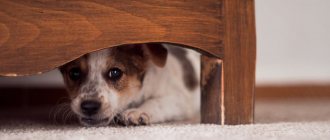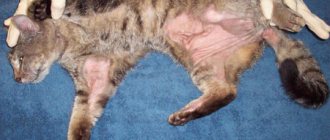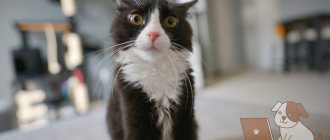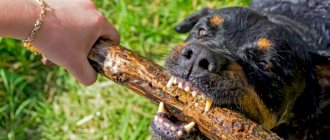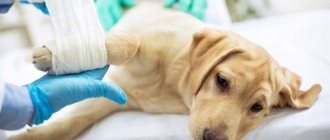Fear is a natural survival mechanism necessary for each of us. It is typical not only for people, but also for four-legged pets. There is nothing wrong with periodic fear if it is associated with an unusual environment or new acquaintances.
Behavior correction is only needed when the animal is afraid of everything or too often. In such a situation, you need to figure out as soon as possible what your dog is most afraid of and how to overcome his fear.
The difference between real fear and manifestations of cowardice
To begin with, it is important to make sure that fear is not associated with cowardice. Cowardly animals experience unreasonable and completely groundless phobias. They are equally frightened by a thunderstorm, which poses a real danger to life, and by an accidentally falling hanger.
Be sure to take your pet to the vet if he is nervous about anything. A weak nervous system is established from birth, and congenital cowardice is incurable. To alleviate the condition, sedatives are used.
In all other cases, cowardice develops for the following reasons:
- cruel treatment;
- keeping in too “greenhouse” conditions and lack of socialization;
- imitation of other animals, that is, the adoption of other people's phobias.
The reaction to a frightening object or situation can be passive-defensive and aggressive-defensive. Both types can be corrected, but the second type will definitely require the help of a dog handler.
Specialist help
Owners should sensibly assess their strengths. In some situations it will not be possible to do without outside help. In this case, you should contact a competent dog handler. It is important to understand that the specialist does not work with the dog. Its task is to teach the owner to interact with his pet. Some specialists are known in several countries at once, such as Antoine Najarian.
Help from a dog handler is quite an expensive pleasure. But should you make a choice: doom your dog to a life of constant fear, or go with it to a dog handler for a while, spend money, but gain peace and mutual understanding? Everyone decides this for themselves.
A dog's fear is not a fatal vice. Some dogs can be trained not to be afraid, while others will have to be protected from the objects of their fear. In any case, the main thing is to give the animal love and affection.
Fear of thunderstorms and fireworks
Fear of thunderstorms and fireworks is the most common fear due to the combination of loud sounds and bright flashes of light. Both are associated with danger and take you by surprise.
While walking
If your pet gets scared on the street, pull on the leash and command “Nearby.” Stay calm and ignore the fear. Otherwise, your emotions will only increase your concerns.
While at home
Follow a similar pattern at home. Don't panic and try to distract your pet. Close all windows, turn on quiet music and divert the four-legged attention to following commands or playing together.
A dog who is afraid to get off the carpet
The dog pees on the bed: why and how to stop it
Sometimes dog breeders are faced with such a problem that their pet is afraid to get off the carpet and moves around the apartment only on covered surfaces.
The reason for the fear is a physical factor - most likely, the laminate or parquet with which the floor is covered is slippery. The animal, not feeling a solid surface under its feet, rolls around on it, falls, and therefore is afraid to get off the reliable surface - the carpet.
Why is a dog afraid of people?
The reasons for possible fear of people are the same as mentioned above - innate inclination, negative experience, insufficient socialization. However, in addition to this, it is worth considering that each animal is individual.
The pet is afraid of people due to past negative experiences
It may be that the dog is unconsciously afraid of a certain person. The reason for this may even be a low timbre of the voice, high stature, or specific odors emanating from a person, for example, the smell of tobacco smoke.
Fear of traveling and visiting the veterinarian
Fear of travel and the veterinarian is associated with a lack of experience or negative experiences. Many dogs get carsick, and the smell of a veterinary clinic is associated with unpleasant procedures.
Accustoming to transport
Try to prove to the dog that there is nothing wrong with the car. To start, just let him sit inside with the doors open. Once he gets used to the cabin, try taking him around the yard. Gradually increase the route and be sure to end the trip with something pleasant: a treat or a walk in the nearest park.
Little tricks
The same trick works with the veterinarian, that is, encouragement after his visit. It’s not for nothing that every clinic places a variety of goodies at the checkout counter.
Another way to fight is to periodically visit the veterinary clinic for the purpose of getting to know each other. Go there not only when you need it, but also when you are just passing by. Be sure to reward your pet for exemplary behavior. He will soon realize that there is nothing scary in this building.
What absolutely should not be done
There are many ways to raise a hysterical, cowardly and potentially dangerous dog. In addition to outright cruelty and boundless indifference, the following can lead to this:
- Shouting, insults and physical abuse in various situations. It doesn’t matter whether the pet misbehaved, didn’t follow a command, or the owner is simply in a bad mood. You cannot take out anger and irritation on an animal, and screaming has never been the right method of education.
- Limiting your pet's communication with other animals. If isolated, the dog will perceive both a huge St. Bernard and a tiny duckling as a threat. The result is a desperate coward with a shattered nervous system.
- Lack of training and regular walks. The dog must receive new information. In addition, it is natural for her to relieve herself in nature, and not in a tray or on a diaper. Isolation has never made anyone brave.
- Prohibition for pets to communicate with pets. In this case, he will perceive everyone as strangers. Of course, dogs of guard breeds should not fawn over strangers on the street, but friendliness will not harm decorative dogs at all. In addition, they will not perceive people as a threat.
- Reluctance to visit a veterinary clinic and grooming salon. This is also a type of communication when a dog finds itself in an extreme situation. Soon she gets used to it and is no longer afraid. For her, a visit to the doctor or a wash, haircut, or nail trimming cease to be stress triggers, so they do not provoke the appearance of fear. If the dog is completely unprepared for such a situation, then his reaction can be unpredictable, which will have a bad effect on the state of the nervous system.
To adapt an animal to everyday life, you need to communicate with it, and not shake it like a porcelain doll. Such treatment can do him a disservice.
Fear of stairs, entrances, elevators
Fear of stairs, entrances and elevators is associated with a lack of experience. Seeing such unusual objects for the first time, the dog may not trust them. Food reinforcement, play, and gentle nudges help to cope with phobias. Here you need to focus on individual reaction.
Special attention should be paid to older dogs. Due to problems with the musculoskeletal system, it is difficult for them to move up stairs. If the pathology is confirmed, carry your pet in your arms. For large breeds, it is recommended to use a harness with a handle.
Rules for successful learning
- Stay safe. Do not point a weapon at people or animals; you may damage their hearing or knock out an eye.
- Take your time. The longer you train your dog, the more reliable and durable the result will be.
- Make sure that the dog does not encounter an irritant outside of your training , otherwise everything learned will go down the drain. If a dog is afraid of fireworks, then you cannot guarantee that there will be no fireworks in the city. Therefore, the best option is to go to the country.
- Be patient. Classes may require quite a long time - about a month. And then it is recommended to train your pet for another month to achieve sustainable results.
- Make the conditions more difficult. When the dog has fully mastered the exercises described in the lesson, it is necessary to accustom it to unexpected shots that are no longer made during special training. Unexpected shots must first also be made at a long distance, gradually reducing it.
- Don't give up. With these exercises you can cope with even the most severe cases. It’s just that the more severe the case, the greater the initial distance to the assistant should be, and the slower it should be reduced.
Fear of walking or being outside
Walking on the street frightens you with unusual sounds. Experience is also required here. During a fright, do not follow your pet's lead. Try to walk not only in closed courtyards, but also near a noisy road. Over time, the dog will get used to the stimuli and stop experiencing stress.
Don't forget the leash. At first it will be especially useful, since without it a panicked pet may get hit by a car.
Stage 1: teach the dog not to be afraid of shots from a long distance
It is better to start training in a place that is familiar and safe for the dog. First, let her sniff the gun well and treat her with a treat, then hand the weapon to the assistant. Next, you keep the dog on a leash, and the assistant moves away 150 steps and shoots upward. If the pet is not scared, then immediately after the shot, praise it and treat it with a treat. If he shows fear, do the same thing when he calms down completely. If you are very scared, tell your assistant to move further away. The next shot can be carried out only when the dog has fully recovered from the current one.
When the dog is no longer afraid of shooting at a given distance, reduce it by 20-30 steps. When he stops reacting at this distance, reduce it further. But most importantly, take your time! It is better to decrease the distance too slowly than too quickly. And it is better to start training from too far a distance than from too little. Over time, begin to move the training to places that are less familiar to the dog and more lively. At the end of each session, just as at the beginning, let your dog sniff the gun and reward it with a treat.
The standard indicators for this exercise are as follows: the dog must calmly react to a shot from a signal pistol at a distance of up to 15 meters (20 steps). However, it will be better if you teach her not to be afraid of shooting at all. You can begin further training and reduce the distance only if the dog fulfills the standard well.
Fear of other animals
This phobia develops in the absence of socialization. Try to find your pet four-legged friends of different sizes and ages so that he does not get used to communicating with one type of animal.
Choose good-natured pets who do not show aggression for joint games. Over time, your coward will not only stop being afraid, but will also begin to enjoy such meetings.
Causes of phobia
Experts have been interested in the issue of dog fear for a very long time. The first place to start correcting unwanted behavior is to identify the cause of its occurrence. Without this, it is impossible to treat a dog for fear of anything.
Hereditary tendency
The dog is afraid of a thunderstorm: what to do and how to calm it down
Fear is innate and is passed on from parents to puppies. Unfortunately, in the modern world this is a very common occurrence. The offspring inherits not only the external qualities of their parents, but also their character traits, behavior and phobias.
Additional Information! Dogs with nervous system problems, timid and fearful individuals are not allowed for breeding.
But it will not be possible to eradicate this problem - a hereditary tendency to fear something is often characteristic of stray dogs that reproduce on their own without hindrance.
Insufficient socialization
It is very easy to spoil even a dog with the most stable nervous system and easy-going character simply by not giving it the necessary upbringing. The process of socialization - learning to live in society - is extremely important and must be controlled from puppyhood.
An unsocialized dog simply does not know the “rules of behavior” among its relatives and does not know how to communicate with them. This is where fear comes from, followed by aggression.
Experienced mental trauma
Unfortunately, a dog can develop a phobia at any age. It is enough to have a bad experience of interacting with the outside world once. For example, city dogs often suffer when firecrackers and firecrackers explode in their legs.
Another clear example is unsuccessful communication with children. Children do not know how to calculate strength, and some of them are prone to unconscious cruelty. The dog, having received such an experience, will be afraid and wary of children. And then he may begin to rush at them in self-defense.
Fear of people
Most often, this type of phobia is associated with mistrust. The method of fighting depends on which people the dog is afraid of.
In front of strangers
Strangers are scary due to lack of socialization or due to negative experience. In the second case, dogs are often afraid of a specific person: a veterinarian, a cyclist, a drunk man.
To eliminate the phobia, try to walk in a small group. Meeting other dog owners will help your pet understand that strangers are not only not scary, but also very friendly.
Treats will add additional delight. Be sure to take a few dog treats with you on your walk and ask your companions to feed your pet. This trick works well not only on a walk, but also at home. If you plan to meet with friends, provide them with a tasty bribe.
In front of the children
Children are frightening with their clumsiness, harshness and noise. Because of this, many dogs assign them the title of especially dangerous objects even at the first meeting.
Be sure to explain to your children the rules for interacting with a four-legged pet. Tell us about his favorite games and places for petting. Carefully ensure that the dog is not disturbed during sleep and rest. A panic attack caused by too tight and sudden hugs can provoke defensive aggression, which can cause injury to the child.
In front of the owner and family members
Sudden fear is usually associated with improper use of punishments and too harsh training. You need to remember the events that happened and work through your mistakes.
Be patient during training and gain the trust of your four-legged dog. Praise him even for the smallest successes. Don’t forget about playing games together, which strengthen the bond with your pet through positive associations.
If the problem is related to life before it came into your family, it is better to contact a dog handler or animal psychologist. You cannot do without professional help even if the dog demonstrates open aggression.
The Importance of Socialization
Socialization is the most important part of education. Thanks to walks in different conditions and getting to know other members of society, the dog gets used not only to strangers, but also to other animals. She learns to distinguish really dangerous things from ordinary ones - and controls her emotions.
Methods of influence
First of all, animal psychologists advise clearly determining the type of nervous system of the animal; there are four types: choleric, sanguine, melancholic and phlegmatic. The first two are more common in dogs with dark coats, the last two - with light coats. Choleric and sanguine people are active and inquisitive fidgets who love active recreation, walks with the owner and fun games. Melancholic and phlegmatic people are more focused, calm, love to sleep, loyal to one owner, very jealous.
Depending on its temperament, the dog will prefer certain behavioral patterns related to the experience of fear. Thus, a dog, sensing a threat, is capable of both rushing at an object that causes him inconvenience and running away from it. Usually, owners already have an idea about the character of their dog and such manifestations of a spontaneous reaction do not surprise them. It is from the preference for choosing a reaction between “bite” and “run” that the further impact on the family pet is built.
Flight response
It is expressed in the fact that when meeting strangers, the dog begins to tear the leash and runs away. If guests come to the house, the pet hides under the bed or hides in the far corner. Typical owner mistakes are that he either starts to chase the pet and punishes it for disobedience, or he chases it and then regrets it. Both options, according to dog handlers, are unproductive. Since in the first case the dog will begin to fear the owner, and in the second, its behavior is reinforced by affection, which means it will be sure that it is doing the right thing.
Animal psychologists advise dealing with such a reaction as follows:
- Allow your four-legged friend to run away to a safe distance from the object causing panic.
- If the dog is not going to stop, then you need to call him loudly by name or stop him using the command “Stop!” In this case, the command “Come to me!” will not give a positive result, since the animal’s fears will not allow him to go back to what causes him anxiety.
- After the pet has stopped, the owner should calmly and measuredly approach him, without showing irritation or anxiety.
- Make sure the dog has stopped shaking, then walk around him from behind and fasten him on the leash. It is acceptable to pet your pet, thereby encouraging it, but without fanaticism.
- Having put the dog on a leash, clearly command him: “Near!” Then distract the animal with play or simple commands such as “Sit!” or “Lie down!”
It is important for the owner to understand that he should be the standard of calm and balance for the dog. Since it is precisely these qualities that the dog lacks, which is why he experiences panic fear of strangers on the street. Dog handlers are sure that animals copy the habits of their “leader”; if their person behaves consistently and does not show anxiety in any way, then the dog’s fear of passers-by will quickly disappear.
Attack reaction
It is expressed in the form of barking or direct attack. Aggression dictated by fear is one of the most dangerous traits of an animal, making it uncontrollable and dangerous to society or family members. If the dog has a habit of using his teeth, the owner must accustom him to a muzzle and give him to dog handlers for re-education. He cannot cope with such behavior alone.
It also happens that the pet only bares its teeth and growls at a threatening object. In this case, you need to shout loudly to him with the command “Quiet!” and pull the leash firmly, if this does not have an effect, then squeeze the dog’s chest between your knees and wait until the annoying subject leaves. Then release your pet and tell him: “Okay!” Under no circumstances should you pet or coax your pet in a gentle voice. By doing this, you only stimulate him to reinforce the wrong behavior.
Remember that training a puppy should begin at 3-4 months. This is the optimal time to learn basic commands such as "Ugh!" and “Quiet!” Do not avoid socializing the animal, try to walk it with its fellow tribesmen from a very young age, then it simply will not have fears of people and other dogs.
Finally, I would like to say that a pet develops a fear of people for a reason. Most often, there are objective reasons for this, for example, negative experiences or severe fear in childhood. Kindness and attentiveness towards your pet, as well as timely and consistent training, will help the owner correct the behavior. Animal psychologists are convinced that there is no bad habit in a dog that cannot be corrected by affection and care from the owner.
What to do if your dog is afraid of everything?
Having figured out the source and cause of the phobia, begin to correct behavior. To do this, you will need to reduce stress levels and increase your four-legged confidence.
Correcting puppy behavior
If the puppy is afraid of everything, do not force things and give him time. Work with the existing problem at a comfortable pace, without forgetting about breaks. Get used to the street gradually, focusing on your pet’s behavior:
- Ignore the fear, but do not leave the baby without support. As soon as the puppy gets scared, call him closer and gently squeeze him between your legs. This position will remind him of his mother’s warmth and reduce anxiety.
- Be sure to stop introducing the frightening object when attacks become more frequent and do not hold the puppy in place by force. Switch your attention to the game, following a command, or giving a treat.
The method that works best is to reinforce positive associations. Give your puppy a treat for every step he walks if he is afraid of stairs, or for every stranger he meets if he is afraid of people.
Adjusting the behavior of an adult animal
Changing behavior as an adult is almost impossible. Here it is better to immediately contact a dog handler, since such four-legged animals require an individual approach.
In some situations, the only way to eliminate a phobia is to take medications. You should consult your veterinarian on this matter.
Stage 2: accustoming the dog to close shots
At this stage, you will also need an assistant, and this should be a person whom the dog knows well. Give the “Sit” command, let your dog sniff the gun and give him a treat. Then, without unfastening the leash, move away from her 2-3 steps. At the same time, the assistant takes the weapon for himself, moves away from the dog at a distance of 10-15 steps and shoots. If everything went well, move on to the next exercise.
Command “Sit” and hand the leash to a helper. Pet the dog, let it smell the gun, give it a treat and repeat the command “Sit!” Move back to the standard distance of 20 steps and fire a shot. Come back, reward the dog with a treat and let him smell the gun again. Next, start training without an assistant - shoot yourself and ensure that the dog remains calmly sitting when shooting. When this stage is passed, start calling the dog after the shot with the command “Come to me,” praise the dog that comes up and let’s sniff the gun. Then gradually reduce the distance. The ideal option is when the dog holds the command “Sit” when the shot is fired in close proximity to him.
At the beginning of training and every time you move on to a new exercise, you should not shoot several times in a row. Wait about 15 minutes, make sure the dog is completely calm, and only then fire the next shot. If, with a new shot, the animal is scared in the same way as with the first one, or more, stop training and resume it only the next day, increasing the distance. However, at the end of the stage it is useful to accustom the dog to a series of shots.
Sometimes it happens that a dog gets stuck at a certain stage of training. For example, a pet does not react to shooting from a distance of 60 steps, but with any attempts to close the distance, it begins to panic. Or the dog calmly takes a shot when the owner is nearby, but becomes a coward if you move a couple of steps away from it. Or he can handle single shots well, but is afraid of a series of shots. This behavior suggests that at some point you were in a hurry and closed the distance too quickly. In this case, take a break for a week and start again from the first stage. Be careful not to move on to the next one prematurely.
Prohibited techniques and mistakes
The appearance of most phobias is associated with a lack of socialization and negative experiences. For this reason, try to avoid the following mistakes:
- Punishment or reward for being scared. In the first case, distrust and fear of people develops, and in the second, belief in the real danger of an event occurring or an object seen is strengthened.
- Avoid contact with other animals and people. Complete isolation is fraught with serious mental problems.
- Insufficient walking and refusal to train. The lack of new information and knowledge negatively affects behavior.
- Refusal to visit a veterinary clinic and grooming salon. Preventive examination and hygiene procedures should be routine, not a surprise.
Be patient and do not hesitate to seek professional help if difficulties arise.
If the pet is from a shelter
Why does a dog eat its own feces: what to do and how to wean it off
Dog breeders who adopt a pet from a shelter are much more likely to encounter various phobias. As a rule, dogs that end up there rarely leave without a traumatized psyche.
Shelter pets are usually very fearful
The reasons are different - if the dog was handed over to a shelter, most likely this indicates a bad attitude towards it on the part of the first owners. If an animal comes to the shelter from the street, then it has experienced a lot of things and probably also has phobias.
Important! The main problem is that it is impossible to accurately determine the cause of the dog’s fear, since its history is unknown.
Even if you get rid of all the physical problems that shelter dogs suffer from, the dog will not be completely healthy. It is important to competently go through the process of adaptation to a new life, to a new home and owners.

